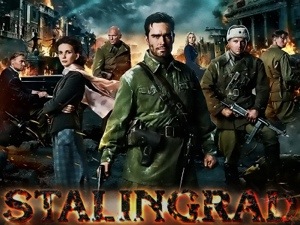The opening scene of Monuments Men shows a painting of the Lamb of God stolen, with millions of other European artworks, by the occupying Germans during WWII. A special U.S. military unit, commissioned by FDR, and led by George Clooney, loosely based on historical reality, strives to retrieve and return the over 5 million looted treasures. One particular masterpiece is a sculpture of Madonna and child, purloined from the cathedral of Bruges. Others are the altar pictorials from Ghent’s cathedral.
Although risking their lives for mostly religious art, and preserving the cultural heritage of Christian Civilization, the Monuments Men never mention religion. They perform their duty, as soldiers and lovers of art, in an entertaining, unpretentious almost wholesome film that recalls old style WWII movies of 40 and 50 years ago like Guns of Navarone and A Bridge Too Far. Gregory Peck and David Niven would be at home in Monuments Men.
The American and Allied characters are noble. A married Matt Damon even declines the offer of a tryst with a French Cate Blanchett. The thieving Germans are sinister. A silent Hitler is shown ominously in the shadows admiring his architectural design for a monstrously reconfigured Berlin. The film has him ordering the mass destruction of stolen art, which in fact is one evil Hitler did not commit.
Enjoyably, the film even swipes at Russians, who are shown likewise stealing art as “reparations” as they advance into Europe. The final climax is the Monument Men‘s retrieval of stolen German art booty, including the Bruges Madonna and Ghent altar paintings, from a salt mine just minutes before avaricious Russian troops arrive, finding instead only an American flag draped over the now empty mine.
Naturally the Russians get better cinematic treatment in the film Stalingrad, a subtitled new Russian movie set against the horrific 1942-1943 battle that was the crest of Nazi advance into the Soviet Union. It was also my first 3D movie, which was at first distracting but ultimately merited the effect of battle debris sifting through the theater. While Monuments Men is virtuous, uncomplicated and often lighthearted, Stalingrad is heavy, dark and ponderous, while also at times magnificent. Russia lost 20 million during an invasion versus America’s 400,000 overseas, so WWII is for them more apocalyptic.
Stalingrad pitted two great totalitarian empires against each other in a murderous wrestle that would allow no survivors. Of 90,000 Germans who surrendered there, only 5000 would survive Soviet captivity. Stalin was as indifferent to human life as Hitler, forbidding Stalingrad residents from fleeing. The movie captures the ghostly horrors of combat amid urban rubble. A German captain, who also keeps a Russian mistress, is portrayed with some nuance. His final peroration to his assaulting troops, extolling to them the Fuehrer who is spiritually omnipresent wherever Germany advances, is malevolently powerful.
Stalin himself, for whom the city is named, making the battle symbolically crucial to both sides, is never directly mentioned in the film but does appear in the background of one scene in an urban propaganda mural. Russians in glorifying their WWII heroics must gingerly avoid their WWII master. Unlike Monuments Men, all of whose major American characters survive (George Clooney’s real life father endearingly portrays his son 30 years after the war), all of the major Russian characters in Stalingrad save one perishes. The survivor’s son, as the narrator, appears in the film’s opening scene, as a doctor rescuing victims after the 2011 Japanese tsunami.
In Stalingrad one Russian soldier crosses himself and another appeals to God, Communism notwithstanding. The Germans also, in twisted fashion, recall their army motto, “God with us.” The Monuments Men don’t cite God although they strive to preserve relics of Christian culture and serve however unconsciously Christian ideals, returning rather than seizing stolen loot.
In contrast with the spirits of Hitler and Stalin that malevolently hang over Stalingrad, FDR and Harry Truman both appear in Monuments Men, each earnestly blessing their mission of cultural preservation. At the end, Truman asks George Clooney if saving art was worth loosing two colleagues. It’s a question that never would have occurred to Hitler and Stalin, who destroyed millions without second thoughts.
No comments yet





